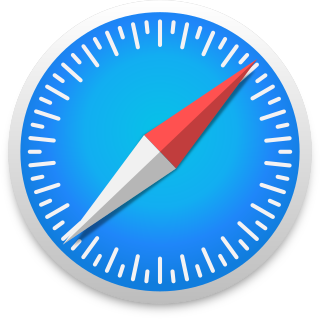Darwin is an open-source Unix-like operating system first released by Apple Inc. in 2000. It is composed of code developed by Apple, as well as code derived from NeXTSTEP, BSD, Mach, and other free software projects.

Safari is a graphical web browser developed by Apple, based on the WebKit engine. First released on desktop in 2003 with Mac OS X Panther, a mobile version has been bundled with iOS devices since the iPhone's introduction in 2007. Safari is the default browser on Apple devices. A Windows version was available from 2007 to 2012.
Cisco Internetwork Operating System (IOS) is a family of network operating systems used on many Cisco Systems routers and current Cisco network switches. Earlier, Cisco switches ran CatOS. IOS is a package of routing, switching, internetworking and telecommunications functions integrated into a multitasking operating system. Although the IOS code base includes a cooperative multitasking kernel, most IOS features have been ported to other kernels such as QNX and Linux for use in Cisco products.
Bonjour is Apple's implementation of zero-configuration networking (zeroconf), a group of technologies that includes service discovery, address assignment, and hostname resolution. Bonjour locates devices such as printers, other computers, and the services that those devices offer on a local network using multicast Domain Name System (mDNS) service records.

In computing, Virtual Network Computing (VNC) is a graphical desktop-sharing system that uses the Remote Frame Buffer protocol (RFB) to remotely control another computer. It transmits the keyboard and mouse events from one computer to another, relaying the graphical-screen updates back in the other direction, over a network.
Remote Desktop Protocol (RDP) is a proprietary protocol developed by Microsoft which provides a user with a graphical interface to connect to another computer over a network connection. The user employs RDP client software for this purpose, while the other computer must run RDP server software.
Nessus is a proprietary vulnerability scanner developed by Tenable, Inc.
OpenVPN is a virtual private network (VPN) system that implements techniques to create secure point-to-point or site-to-site connections in routed or bridged configurations and remote access facilities. It implements both client and server applications.
Cisco PIX was a popular IP firewall and network address translation (NAT) appliance. It was one of the first products in this market segment.

Apple Remote Desktop (ARD) is a Macintosh application produced by Apple Inc., first released on March 14, 2002, that replaced a similar product called Apple Network Assistant. Aimed at computer administrators responsible for large numbers of computers and teachers who need to assist individuals or perform group demonstrations, Apple Remote Desktop allows users to remotely control or monitor other computers over a network.

LogMeIn Hamachi is a virtual private network (VPN) application written by Alex Pankratov in 2004. It is capable of establishing direct links between computers that are behind network address translation ("NAT") firewalls without requiring reconfiguration ; in other words, it establishes a connection over the Internet that emulates the connection that would exist if the computers were connected over a local area network ("LAN").
Cisco NAC Appliance, formerly Cisco Clean Access (CCA), was a network admission control (NAC) system developed by Cisco Systems designed to produce a secure and clean computer network environment. Originally developed by Perfigo and marketed under the name of Perfigo SmartEnforcer, this network admission control device analyzes systems attempting to access the network and prevents vulnerable computers from joining the network. The system usually installs an application known as the Clean Access Agent on computers that will be connected to the network. This application, in conjunction with both a Clean Access server and a Clean Access Manager, has become common in many universities and corporate environments today. It is capable of managing wired or wireless networks in an in-band or out-of-band configuration mode, and Virtual Private networks (VPN) in an in-band only configuration mode.

SSL-Explorer: Community Edition was an open-source SSL VPN product developed by 3SP Ltd, a company acquired by Barracuda Networks. It is licensed under the GNU General Public License (GPL), and is aimed primarily at smaller businesses that need remote access to internal network resources.
Tunnelblick is a free, open source graphic user interface for OpenVPN, a Virtual Private Network (VPN), on OS X and macOS. It provides easy control of OpenVPN client and/or server connections.
QVD is an open-source virtual desktop infrastructure (VDI) product built on Linux. Its main purpose is to provide remote desktops to users.
University of Tsukuba Virtual Private Network, UT-VPN is a free and open source software application that implements virtual private network (VPN) techniques for creating secure point-to-point or site-to-site connections in routed or bridged configurations and remote access facilities. It uses SSL/TLS security for encryption and is capable of traversing network address translators (NATs) and firewalls. It was written by Daiyuu Nobori and SoftEther Corporation, and is published under the GNU General Public License (GPL) by University of Tsukuba.

Mozilla is a free software community founded in 1998 by members of Netscape. The Mozilla community uses, develops, spreads and supports Mozilla products, thereby promoting exclusively free software and open standards, with only minor exceptions. The community is supported institutionally by the not-for-profit Mozilla Foundation and its tax-paying subsidiary, the Mozilla Corporation.
OpenConnect is an open-source software application for connecting to virtual private networks (VPN), which implement secure point-to-point connections.

SoftEther VPN is free open-source, cross-platform, multi-protocol VPN client and VPN server software, developed as part of Daiyuu Nobori's master's thesis research at the University of Tsukuba. VPN protocols such as SSL VPN, L2TP/IPsec, OpenVPN, and Microsoft Secure Socket Tunneling Protocol are provided in a single VPN server. It was released using the GPLv2 license on January 4, 2014. The license was switched to Apache License 2.0 on January 21, 2019.
OpenH264 is a free software library for real-time encoding and decoding video streams in the H.264/MPEG-4 AVC format. It is released under the terms of the Simplified BSD License.







